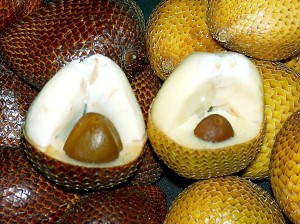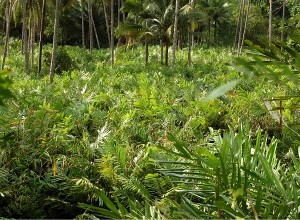 Salak (Salacca zalacca), also known as snake fruit due to the reddish-brown scaly skin, is a species of palm tree (family Arecaceae) native to Indonesia. It is a very short-stemmed palm, with leaves up to 6 meters (20 ft) long; each leaf has a 2-meter long petiole with spines up to 15 centimeters (5.9 in) long, and numerous leaflets.
Salak (Salacca zalacca), also known as snake fruit due to the reddish-brown scaly skin, is a species of palm tree (family Arecaceae) native to Indonesia. It is a very short-stemmed palm, with leaves up to 6 meters (20 ft) long; each leaf has a 2-meter long petiole with spines up to 15 centimeters (5.9 in) long, and numerous leaflets.
The fruit grow in clusters at the base of the palm. They are about the size and shape of a ripe fig, with a distinct tip. The pulp is edible. The fruit can be peeled by pinching the tip, which should cause the skin to slough off so it can be pulled away. The fruit inside consists of three lobes, each containing a large inedible seed. The lobes resemble, and have the consistency of, large peeled garlic cloves. A ripe salak is always creamy yellow color and has a sweet acid taste like pineapple. Salak is not juicy which makes them especially convenient to peel and eat. The taste is usually sweet and acidic, but its apple-like texture can vary from very dry and crumbly to moist and crunchy.
Salak fruit has is indigenous to and has been cultivated throughout Indonesia, and there are at least 30 cultivars. Two popular cultivars are salak pondoh from Yogyakarta province (found in 1980s) and salak Bali from Bali island.
Production of Salak or Snake Fruit
History of cultivation
Salak is cultivated in Thailand, throughout Malaysia and Indonesia as far as the Moluccas, and has been introduced into New Guinea, the Philippines, Queensland (Australia), Ponape Island (Caroline Archipelago) and reportedly occurs on the Fiji Islands.
Natural Habitat
Salak thrives under humid tropical lowland conditions. Because of its superficial root system, the palm requires a high water table, rain or irrigation during most of the year, but it does not stand flooding. Fruit yield and quality in Java diminish above 500 m altitude. Salak is usually grown under shade.
Salak grows wild in south-western Java and southern Sumatra, but its precise place of origin is not known. It is cultivated in Thailand, throughout Malaysia and Indonesia as far as the Moluccas, and has been introduced into New Guinea, the Philippines, Queensland (Australia), Ponape Island (Caroline Archipelago) and reportedly occurs on the Fiji Islands.
Biophysical Limits
Altitude: Below 500 m, Average annual rainfall: 1700-3100 mm., Soil types: Soil types in production centres include podzolic soils and regosol.
Reproductive Biology
The palm starts flowering three to four years after sowing. Pollination is probably by insects, notably a weevil, tentatively identified as Nodocnemis sp. In Queensland, Australia, pollen is carried from palm to palm by curculionid beetles, large numbers of which visit the flowers. The fruits are mature five to seven months after pollination. In principle, the palm flowers and fruits continuously, but most reports indicate harvest peaks around May and – a major one – around December in Indonesia. This implies a top fruit set in June-July, i.e. the first half of the dry season, following the small harvest peak. The palm can be productive for 50 years or more.
Propagation Methods
Seeds are sown directly in the field (2-5 seeds together in 5 cm deep holes) or in nursery beds. The seedlings are planted out in the field during the rainy season when they are a few months old. Seed kernels taken directly from the fresh fruit germinate readily in less than a week under moist, shady conditions, even on top of the soil. After removal from the fruit the kernels quickly lose viability in storage, probably because the embryo dries out irreversibly: 55% germination was found after 1 week, 0% after 2 weeks. Germination becomes visible when the cylindrical embryo-containing plug is extruded through the germ pore at the kernel’s apex. A radicle soon emerges from the tip of the plug and the shoot, a main root and several secondary roots emerge from the sides of this plug. About 60-90 days after sowing the first complete leaf, bifid and some 20-30 cm long, is fully expanded, the seedling still being firmly attached to the kernel. Vegetative propagation is less common. It involves removing rooted lateral offshoots from older plants, or, with higher rates of success, layering or air layering 3-6-month-old shoots.
Tree Management
Young palms require heavy shade which may be reduced after about one year. Salak palm, especially when young, is intercropped in mixed gardens with banana, mango and Artocarpus spp. Male trees are maintained at a rate of 2-20%, evenly dispersed among the female trees or as guard rows around them. Plant distances encountered vary from less than 2 m to 6 m. Husbandry: Weeding is necessary before the leaf canopy is closed. Basal suckers are usually cut out in order not to lower the fruit yield of the mother palm. Lateral shoots may be spared to grow into fruiting stems or to be used for vegetative propagation. If the erect portion of the stem grows too tall, the palm loses vitality, probably because the young roots formed immediately under the crown cannot reach the soil. To rejuvenate the palm, farmers usually push the stem back into the ground and earth it up. Ageing plant parts are cut off and either buried between the palms or burned, the ash being used as fertilizer. Adequate use of fertilizers may make shading in salak cultivation less necessary than is generally assumed. Farmyard manure as well as urea, triple superphosphate and potassium muriate are reported to have been tried by farmers. Fruit taste may be negatively or positively influenced by fertilizing. Exclusive use of urea is said to produce large but perishable fruits, and also to cause strong vegetative growth which increases the risk of the palms toppling over. Irrigation is necessary during the dry season if the superficial root system of the palm cannot reach the water table. In many places hand pollination is practiced by tapping a flowering male spike held above a female inflorescence. Fruit bunches are usually thinned to provide space for the remaining fruits to grow larger. The supporting leaf of a bunch is sometimes pruned to ensure undisturbed development of the bunch. In some places the bunch is tied up because it is believed that if it develops hanging down, the taste is less good.
Products
Food: Salak palm is cultivated for its fruits, the bulk of which are consumed fresh when fully ripe. In Indonesia the fruits are also candied (‘manisan salak’), pickled (‘asinan salak’) and fresh unripe ones may be used in ‘rujak’, a spicy salad of unripe fruit. Mature fruits may be canned. The seed kernels of the young fruits of the Javanese ‘Pondoh’ form are edible. Other products: The bark of the petioles may be used for matting. The leaflets are used for thatching.
Services
Boundary or barrier or support: A closely-planted row of palms forms an impregnable hedge and the very spiny leaves are also cut to construct fences.
Pests and Diseases
Diseases: In Java a fungus disease provisionally identified as Mycena sp. sometimes occurs, especially during the wet season; white mycelium overgrows the bunch and fruits finally rot. The fungus Pestalotia sp. causes black spots on the leaves; growers attempt to check the disease by cutting and burning affected leaves. Pink disease (Corticium salmonicolor) can cause serious loss of fruit and plants. Control depends largely on reducing the infection pressure by early removal of diseased parts; proper ventilation to lower the humidity in the crop is also important. Pests: Larvae of the weevils Omotemnus miniatocrinitus and O. serrirostris which tunnel into the top of the palm, and of the weevil Nodocnemis sp. which bore into the young fruit bunches, are occasionally harmful. On the other hand, the latter insect is a pollinator. Growers control weevils by poking a piece of wire into the holes. There are reports of an unidentified grub feeding on the roots and devastating entire stands of salak orchards in central Java. Pests reported to feed on salak palm without indication of harmfulness include the monophagous beetle Calispa elegans, the polyphagous caterpillar Ploneta diducta, a leaf roller (Hidari sp.), the scale insect Ischnaspis longirostris and a bug (Tolumnia sp.), as well as several rodents such as rat and luwak (Paradoxurus hermaphroditus).
Properties
Food: The flesh is exceptionally firm and crisp for a tropical fruit. It is quite sweet when fully ripe, but unripe fruit is sour and astringent due to the presence of a little tannic acid. When the fruit is ripe, a layer of granular-looking flesh adheres to the kernel, a state known as “masir” in Indonesia; whereas each kernel of an immature fruit lies free in a cavity in the flesh. The unique taste is somewhat comparable to a combination of apple, pineapple and banana.
Trade
Data on production and cultivated area are scarce and variable. Production figures for Java range from 7000-50 000 t in the 1980s, about half the crop being produced in western Java. In Indonesia, where salak is exclusively a smallholder crop, only a tiny fraction of total production is exported, fresh, canned or candied, mainly to or through Singapore.

Harvesting
Harvesting takes place at a fruit age of 5-7 months, or somewhat earlier if rains cause fruits approaching maturity to swell too quickly and burst. Fruits are harvested by cutting the bunches with a reaping hook. The seasonality generally observed in fruiting (for example, in Java) is probably caused by the negative influence of excessive drought or excessive rain on flowering and/or pollination. Where palms have access to water throughout the year (through a high water table or irrigation), fruiting is indeed more evenly spread over the year. Yield: The scarce data available suggest that annual yields vary from 5-15 t/ha.
Handling after harvest: Fruits picked when not too ripe will stand 2 or 3 days of transportation, for example in bamboo baskets. In a hot and humid climate, fresh fruit will not last much longer than a week after picking. The slightest injury accelerates spoiling. There is a need to establish maturity indices for harvesting and techniques to control fruit rot in order to extend shelf life. Farmers or retailers often sort salaks into size classes before selling them.
Sources: wikipedia.org, worldagroforestrycentre.org; Photos: rawketscience.blogspot.com, panoramio.com